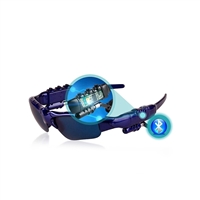
The distinctions of portable and home headphones are melting away, but the following rundown of headphone types will clarify your buying options. How you intend to use your headphones -- for music, home theater, or gaming -- and where you plan to do your listening -- at home or on the go -- will narrow the range of possible types you will want to research....
The distinctions of portable and home headphones are melting away, but the following rundown of headphone types will clarify your buying options. How you intend to use your headphones -- for music, home theater, or gaming -- and where you plan to do your listening -- at home or on the go -- will narrow the range of possible types you'll want to research. The four major form factors are listed below, from the smallest (or most portable) to the largest, which are the least portable.
1. Earbud headphones
Also known as: In-ear headphones.
Earbuds are commonly issued as freebie headphones with portable players and usually get junked in favor of higher-performance buds that offer sonics rivaling full-size models. Their tiny earpieces rest on the outer ear or need to be inserted into the ear canal, and some models include clips for a more tailored, secure fit.
Upside: Ultracompact and lightweight; most models have microphone and track navigation controls built into the wire; can provide moderate to excellent isolation from external noise; little to no interference with earrings, glasses, hats, or hairstyles.
Downside: Sound quality and bass response often not comparable with full-size models; can sometimes cause discomfort over extended use; some reference models are difficult to insert and remove, making them less than ideal for office environments; dual-cable design means more possibilities for tangled wire.
Extra features: Five-button remote to control volume; variety of ear tip sizes and materials (foam, rubber, silicone); over-ear guides; multiple balanced-armature drivers with crossover.
2. On-ear headphones
Also known as: Supra-aural headphones, open-backed headphones, semi-open headphones, closed-back headphones, earpad headphones.
These headphones rest on top of your outer ears and run the gamut from inexpensive portables to high-end home models. While on-ear headphones can have closed designs that cover the ears, some prefer fully sealed circumaural models (see below) for their increased sound isolation and the fact that they won't leak sound to neighbors. Still, the earpad headphone is preferred in places like office environments, where users still benefit from hearing the outside world.
Upside: Comfortable; less prone to overheating ears than full-size headphones; some models fold up for easy transport.
Downside: Less effective noise isolation than in-ear or full-size models; less powerful bass compared with full-size headphones; leaks noise to neighbors.
Extra features: Microphone and track navigation controls on the wire; extra earpad set included; carrying case; folding design; coiled and straight cord.
3. Full-size headphones
Also known as: Circumaural headphones; closed-back headphones; earcup headphones; over-the-ear headphones..
The tech-speak description for this type of headphone is "circumaural," which includes any headphones with earcups that fully enclose your ears. Because of their size and their acoustic isolation, full-size headphones are often considered to be better suited to home use rather than as a portable option, but the recent popularity of Monster's full-size, noise-canceling Beats headphones are challenging the rule.
Upside: Large headphones offer potential for maximum bass and loudness levels; earcups create larger sound stage; surround-sound effectively blocks outside noises, seals music in.
Downside: Large footprint can be cumbersome for portable use; some full-size models have problems with heat on the ears; wide headband can often interfere with earrings, glasses, and some hairstyles.
Extra features: Folding design; detachable cord; microphone, track navigation, and volume controls on the wire; replaceable pads; extra 3.5mm plug for daisy-chain sessions with multiple listeners.
4. Wireless headphones
Also known as: Bluetooth headphones, transmitter headphones.
Wireless headphones are most commonly used (A) in apartments with thin walls that don't permit loud media from bookshelf speakers, and (B) on the run where a dangling cord can get in the way. The most popular format for transmitting wireless music is Bluetooth, but keep in mind that you'll sacrifice sound quality to convenience in the file compression process. To combat this audio degradation, some of the newer headphones support the aptX Bluetooth codec that offers slightly improved fidelity.
Upside: No messy wires to trip you up; falling prices make Bluetooth headphones a reasonable auxiliary device for workouts and portable use.
Downside: The music stops when your battery dies; compressed audio files will leave your music sounding less dynamic; less real estate on the headphones means smaller buttons to control track navigation and volume; hardware limitations relegate its use to devices with Bluetooth connectivity.
Extras: Active noise-cancellation; 3.5mm port, and cable for a hardwired connection; replaceable earpads; travel case.
5. Noise-canceling headphones
These headphones hush ambient noise by creating antinoise that obviates the noise at your ear. They don't eliminate the outside world, but the better models significantly reduce the whoosh of airplanes' air-conditioning systems. Noise-canceling headphones come in all forms, from full-size to earbuds. Since you no longer have to crank up the volume to overcome background noise, this type of headphone lets you listen at lower levels, which leads to reduced ear fatigue. You'll also hear more low-level detail in your music.
Upside: Active noise-canceling technology eliminates ambient noise; ideal for plane rides and morning commutes.
Downside: Alters the "natural" qualities of music; some people experience an "underwater" nausea effect from the noise-canceling hum.
Extras: Wireless connection; travel case; rechargeable batteries; on-ear navigation and volume controls.
Customer Service
